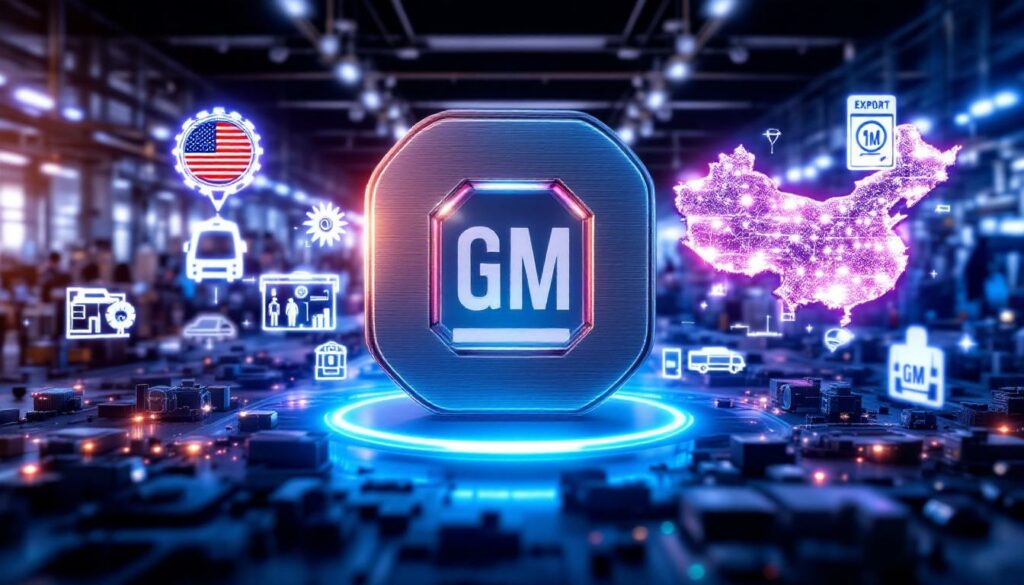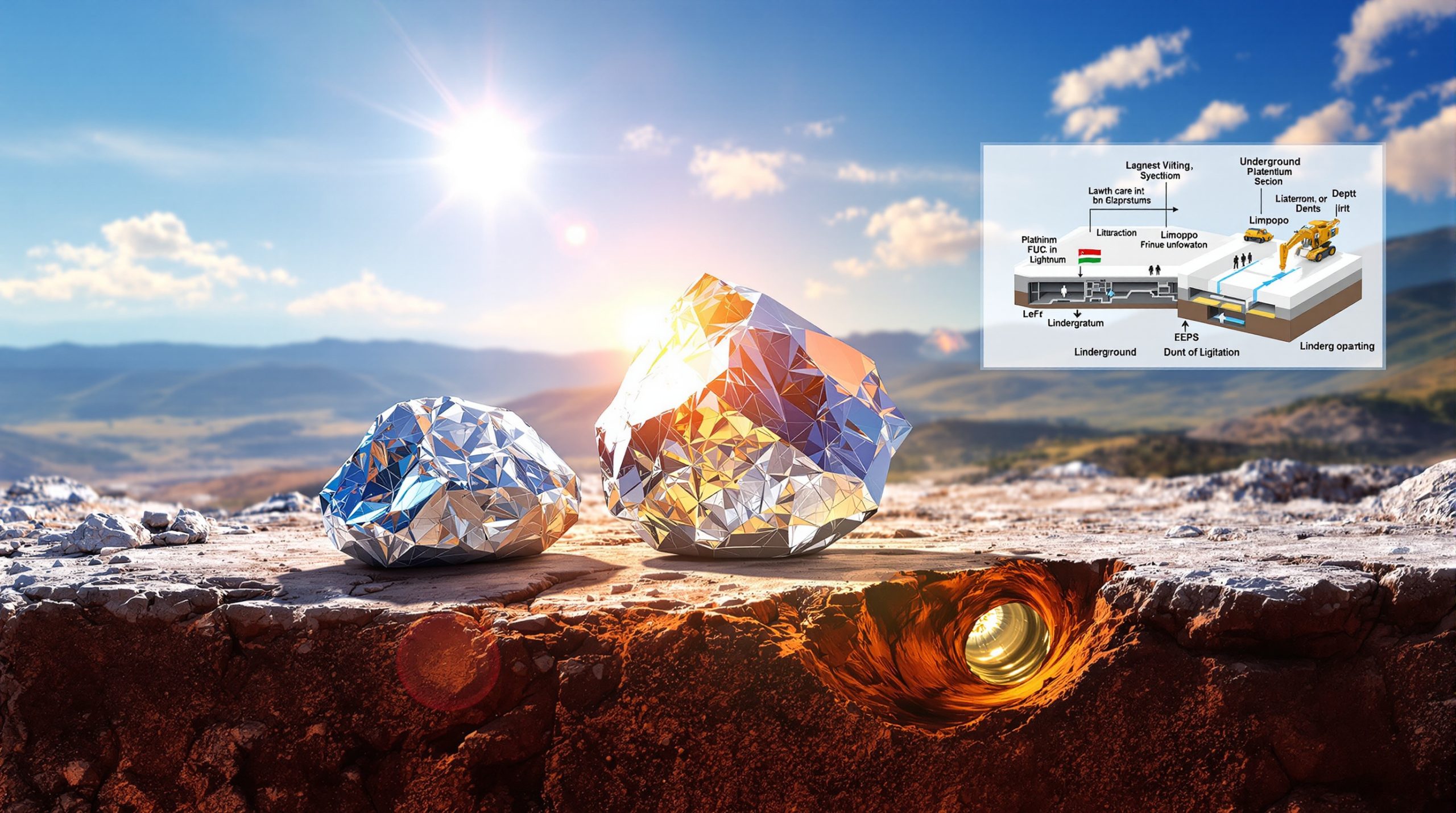What Does GM’s New Rare Earth Magnet Deal Include?
General Motors has taken a significant step toward securing its supply chain by entering into a multi-year agreement with Noveon Magnetics, the only operational manufacturer of sintered neodymium-iron-boron (NdFeB) magnets in the United States. The deal, which began deliveries in July 2023, focuses on supplying these critical components for GM’s full-size SUVs and trucks.
This partnership represents the first major automotive deal for Noveon, establishing the company as a key player in the domestic rare earth magnets market. While specific contract values remain undisclosed, industry analysts note the strategic importance extends beyond financial considerations.
Key Partnership Details
The agreement centers on the provision of sintered NdFeB magnets, which are considered the strongest permanent magnets commercially available. These components are essential for numerous automotive applications, particularly in powertrain systems.
“This partnership marks a watershed moment for domestic rare earth magnet production,” noted a GM representative in a statement to Reuters. “Building resilient supply chains for critical components is vital to our manufacturing future.”
The deal specifically targets components for GM’s most profitable vehicle segment—full-size SUVs and trucks—underscoring the strategic importance GM places on securing these materials for its core business.
Strategic Timing and Market Context
This arrangement comes at a particularly sensitive time in global supply chains. With China controlling over 90% of global rare earth processing capacity and implementing new export licensing rules in April 2023, automotive manufacturers have faced increasing uncertainty around access to these critical materials.
By securing a domestic source, GM positions itself to better navigate potential supply disruptions that have already affected competitors. Ford executives have publicly acknowledged that pinched supply of rare earth magnets from China disrupted their production schedules in recent months.
Industry experts view this deal as part of a broader trend toward supply chain nationalization, particularly for materials deemed critical to economic and national security. The timing suggests GM is proactively addressing vulnerabilities exposed during recent global supply chain disruptions.
Why Are Rare Earth Magnets Essential in Modern Vehicles?
Rare earth magnets, particularly neodymium-iron-boron (NdFeB) magnets, have become indispensable components in modern vehicle manufacturing. Their exceptional strength-to-weight ratio makes them ideal for applications where space and weight considerations are paramount.
“The magnetic field strength these components provide simply can’t be matched by conventional alternatives,” explains Dr. James Litinsky, materials science expert at Northwestern University. “For automakers pushing the boundaries of efficiency and performance, they’re not just beneficial—they’re essential.”
Critical Applications in Automotive Systems
In today’s vehicles, rare earth magnets serve numerous critical functions:
- Electric motors and generators: Providing the magnetic field necessary for efficient power conversion
- Power steering systems: Enabling precise control with compact components
- Sensors and actuators: Supporting everything from window lifts to safety systems
- Speaker systems: Delivering audio performance in increasingly compact designs
- Starter motors: Providing reliable engine ignition
For electric vehicles specifically, these magnets are foundational components in permanent magnet motors, which offer superior efficiency and power density compared to alternatives. A typical electric vehicle can contain several kilograms of rare earth materials, primarily in motor assemblies.
Technical Advantages of NdFeB Magnets
The technical superiority of NdFeB magnets explains their dominance in automotive applications:
| Property | Advantage | Automotive Benefit |
|---|---|---|
| Magnetic strength | Up to 10x stronger than ferrite magnets | Smaller, lighter components |
| Temperature stability | Maintains performance up to 180°C with additives | Reliable under harsh operating conditions |
| Coercivity | Resists demagnetization | Durability in dynamic environments |
| Energy product | Highest energy density of commercial magnets | Maximum efficiency in power applications |
These performance characteristics make NdFeB magnets virtually irreplaceable in many automotive systems, particularly those focused on electrification and advanced driver assistance technologies.
How Is China Controlling the Global Rare Earth Supply Chain?
China’s dominance over the rare earth supply chain represents one of the most concentrated resource monopolies in modern industrial history. This control extends beyond raw material extraction to encompass the entire value chain of processing, refining, and manufacturing.
Market Dominance Statistics
The extent of China’s control is staggering:
- Controls over 90% of global rare earth processing capacity
- Produces approximately 85% of the world’s refined rare earth products
- Manufactures nearly 90% of all rare earth permanent magnets
- Holds significant mining operations both domestically and through international investments
- Implemented new export licensing rules in April 2023, adding another layer of control
This dominance did not happen by accident. Beginning in the 1980s, China recognized the strategic importance of rare earth elements and invested heavily in developing extraction and processing capabilities while many Western nations allowed their domestic industries to atrophy.
“China’s rare earth strategy has been decades in the making,” notes Dr. Victoria Bruce, author of “Sellout: How Washington Gave Away America’s Technological Soul.” “What we’re seeing now is the culmination of a long-term industrial policy that recognized these materials would be critical minerals energy transition to 21st-century technologies.”
Impact on Western Manufacturing
The consequences of this dependency have become increasingly apparent:
Ford executives have publicly acknowledged that restricted supply of rare earth magnets from China disrupted their production schedules, highlighting the vulnerability of even the largest manufacturers.
Industry reports indicate that Western manufacturers face price premiums of 20-30% when attempting to secure rare earth materials outside Chinese supply channels, creating significant cost pressures.
The automotive sector faces particular challenges due to the volume of materials required and the specialized processing needed for automotive-grade components. With limited alternative suppliers, manufacturers have few options when supply constraints emerge.
Military applications face even greater challenges, as defense contractors must navigate both commercial supply limitations and restrictions on using Chinese-sourced materials in critical defense systems.
What Broader Industry Implications Does This Deal Signal?
GM’s deal with Noveon Magnetics represents more than a simple supply arrangement—it signals a fundamental shift in how automakers approach supply chain vulnerability and strategic materials.
Supply Chain Resilience Strategies
The automotive industry is increasingly adopting multi-faceted approaches to address rare earth supply challenges:
- Vertical integration: Taking ownership stakes in mining and processing operations
- Geographic diversification: Developing supply relationships outside China
- Material innovation: Research into reduced-rare-earth or rare-earth-free alternatives
- Recycling initiatives: Developing technologies to recover rare earths from end-of-life products
- Long-term contracts: Securing supply through extended agreements with favorable terms
These approaches reflect a broader industrial recognition that just-in-time supply chains optimized solely for cost efficiency create dangerous vulnerabilities when applied to critical materials.
“The era of assuming global supply chains will always function smoothly is over,” states Dr. Eugene Gholz, former Pentagon senior advisor on industrial policy. “We’re seeing a shift toward resilience over pure efficiency, particularly for materials with strategic importance.”
Electric Vehicle Production Challenges
For electric vehicle manufacturers, the stakes are particularly high:
Automakers, especially those focused on electric vehicles, are among the largest industrial consumers of rare earth materials. A typical EV can use 1-2 kilograms of neodymium in its motors, with high-performance models requiring even more.
“The transition to electric vehicles cannot succeed without addressing rare earth supply security,” cautions Dr. Simon Moores, materials supply chain analyst. “We’re talking about materials that are fundamental to the performance of these vehicles.”
Recent supply constraints have reportedly forced several manufacturers to delay production plans or redesign components to accommodate available materials. Industry sources suggest that supply uncertainty has become a key factor in product development decisions.
The price volatility of rare earth materials—which can fluctuate by 200-300% during supply disruptions—creates significant challenges for cost forecasting and pricing stability.
How Is the US Building Domestic Rare Earth Capability?
The United States has begun a concerted effort to rebuild domestic capability across the rare earth supply chain, driven by both national security concerns and industrial policy objectives.
Manufacturing Renaissance Efforts
Several initiatives highlight this growing focus:
Noveon Magnetics stands as the only operational US manufacturer of sintered NdFeB magnets, representing a critical beachhead for domestic production. Their facility demonstrates that commercial-scale production is viable on US soil despite higher operating costs.
The US Department of Energy has committed over $156 million to rare earth and critical materials research through various programs, aiming to develop both new technologies and processing capabilities.
Public-private partnerships, including those under the Defense Production Act, have accelerated domestic capacity development that might otherwise be commercially unviable in the short term.
Investments in training and workforce development aim to rebuild the specialized knowledge base required for advanced materials processing, much of which has been lost as manufacturing moved offshore.
Policy and Regulatory Framework
The policy environment has evolved significantly to support domestic rare earth production:
The US government has designated rare earth elements as “critical minerals” essential to economic and national security, unlocking special funding and regulatory consideration.
Tax incentives, including those in the Inflation Reduction Act, provide financial support for domestic manufacturing of components using critical minerals sourced from the US or free trade agreement partners.
The CHIPS and Science Act includes provisions supporting advanced materials manufacturing, providing additional funding streams for rare earth processing development.
Export controls on certain technologies have been implemented to protect intellectual property related to rare earth processing and magnet manufacturing.
Defense procurement policies now include domestic sourcing requirements for critical materials, creating a baseline market for US producers. The Trump executive order on minerals further reinforced this policy direction with specific mandates for developing domestic supply chains.
What Technical Processes Are Used in Rare Earth Magnet Production?
The production of rare earth permanent magnets involves a complex series of processes that combine materials science, metallurgy, and precision manufacturing.
Manufacturing Process Overview
The journey from mine to magnet includes several critical stages:
- Mining and concentration: Extracting ore containing rare earth elements and concentrating it through physical separation
- Chemical separation: Using acids and solvents to isolate individual rare earth elements
- Metal reduction: Converting rare earth oxides to pure metals through electrolysis or metallothermic reduction
- Alloy creation: Precisely combining neodymium, iron, boron and small amounts of other elements
- Powder production: Converting the alloy to fine powder with specific particle characteristics
- Forming and sintering: Compacting the powder and heating it to create solid magnets
- Machining and coating: Finalizing dimensions and applying protective coatings
- Magnetization and testing: Applying a strong external field and verifying performance
Each step requires specialized equipment and expertise, with tight quality control throughout the process.
Sintered NdFeB Magnet Production Steps
The creation of sintered NdFeB magnets—the type being supplied to GM by Noveon—involves particularly demanding technical requirements:
- Powder preparation: The process begins with hydrogen decrepitation, where the NdFeB alloy absorbs hydrogen and breaks into a coarse powder
- Jet milling: This coarse powder is further refined using jet mills to create particles in the 3-5 micron range—smaller than a red blood cell
- Magnetic alignment: During pressing, a magnetic field aligns the particles to maximize the magnet’s eventual strength along a preferred direction
- Sintering: The compacted powder is heated to approximately 1080°C in vacuum furnaces, causing the particles to fuse
- Heat treatment: Multiple precisely controlled heating and cooling cycles optimize the microstructure
- Surface treatments: Protective coatings (typically nickel, zinc, epoxy, or gold) prevent corrosion
This process requires extraordinarily precise control of composition, temperature, particle size, and processing conditions to achieve the desired magnetic properties.
What Environmental Considerations Surround Rare Earth Processing?
The environmental footprint of rare earth processing represents one of the industry’s most significant challenges, with implications across the entire supply chain.
Extraction Challenges and Impacts
Rare earth mining and processing create several environmental concerns:
- Chemical intensity: Separation processes typically use strong acids, bases, and organic solvents
- Radioactive elements: Many rare earth deposits contain naturally occurring radioactive materials like thorium and uranium that must be managed
- Water usage: Processing requires substantial water volumes, with potential for contamination if not properly managed
- Energy consumption: From mining through separation and manufacturing, rare earth processing demands significant energy
- Waste generation: For every ton of rare earth oxides produced, approximately 2,000 tons of mining waste may be generated
These challenges have historically concentrated in regions with less stringent environmental regulations, particularly in China, creating a regulatory arbitrage that disadvantaged producers in countries with stricter standards.
“The environmental cost of rare earth production has largely been externalized from Western consumption,” notes environmental policy analyst Dr. Jennifer Turner. “But as production shifts globally, addressing these impacts becomes unavoidable.”
Sustainability Initiatives in the Industry
The industry is increasingly developing more sustainable approaches:
- Improved separation technologies: New solvent extraction methods reduce chemical consumption by up to 30%
- Recycling developments: Urban mining from electronic waste can recover up to 90% of rare earths in certain applications
- Closed-loop processing: Advanced facilities recapture and reuse water and chemicals
- Renewable energy integration: Some new processing facilities utilize renewable energy to reduce carbon footprint
- Bioextraction research: Experimental approaches use microorganisms to separate rare earths with minimal chemical inputs
These advances suggest that domestic production can potentially achieve both security of supply and improved environmental performance compared to historical processing methods. The mining sustainability transformation currently underway in the industry is helping address many of these challenges.
How Does This Deal Compare to Other Automotive Supply Chain Strategies?
The GM-Noveon agreement represents one approach within a spectrum of strategies automakers are employing to address rare earth supply challenges.
Competitive Landscape Analysis
Major automakers have adopted varied approaches:
- Toyota: Has invested directly in mining operations while also developing reduced-rare-earth motor designs
- Tesla: Initially focused on induction motors that avoid rare earth elements, but has incorporated permanent magnet motors in newer models while exploring recycling technologies
- Volkswagen Group: Pursuing direct supply agreements with miners outside China while funding alternative motor research
- BMW: Developed contracts requiring suppliers to source raw materials from certified mines with environmental and social standards
These strategies reflect different assessments of supply risk, technical requirements, and corporate priorities. GM’s approach with Noveon emphasizes domestic supply security through a direct supplier relationship rather than vertical integration or materials substitution.
Future Outlook for Automotive Rare Earth Usage
Several factors will shape rare earth usage in automotive applications over the coming decade:
Industry projections suggest electric vehicle production could require three times the current volume of rare earth materials by 2030, potentially outpacing supply expansion.
Motor design innovations are reducing per-vehicle rare earth content, with some manufacturers achieving 20-30% reductions through improved designs.
| Year | Projected EV Production | Est. Rare Earth Demand | Potential Supply Gap |
|---|---|---|---|
| 2023 | 10.5 million | 25,000 tonnes | Minimal |
| 2025 | 14.8 million | 33,000 tonnes | 3,000-5,000 tonnes |
| 2030 | 28.2 million | 58,000 tonnes | 8,000-12,000 tonnes |
Note: Estimates vary significantly based on assumptions about motor design evolution and mining capacity expansion
Recycling is expected to provide an increasing percentage of supply, potentially reaching 15-20% of demand by 2030 as the first generation of EV motors reaches end-of-life.
These trends suggest that securing stable supply will remain a strategic priority for automakers despite efforts to reduce dependency. The ongoing US‑China trade impact continues to shape these supply chain decisions as companies navigate geopolitical tensions.
FAQ: Rare Earth Magnets in the Automotive Industry
What makes rare earth magnets essential for modern vehicles?
Rare earth magnets provide unmatched magnetic strength in compact sizes, enabling smaller, lighter, and more efficient components. In electric vehicles, they enable motors that are up to 30% smaller than alternatives while maintaining equivalent power output. For conventional vehicles, they support everything from power steering systems to sensors that enable advanced driver assistance features.
How does the GM-Noveon deal affect US manufacturing capabilities?
This partnership strengthens domestic manufacturing by supporting the only US-based producer of sintered NdFeB magnets. It provides Noveon with a major automotive customer that can help scale operations and potentially catalyze additional domestic investment. The arrangement also demonstrates commercial viability for US-based production, potentially encouraging other manufacturers to develop domestic capacity.
What alternatives exist to rare earth magnets?
While alternatives include ferrite, samarium-cobalt, and aluminum-nickel-cobalt magnets, these typically offer lower performance characteristics. Some manufacturers are developing switched reluctance motors and wound-field synchronous motors that eliminate rare earth requirements, but these designs often face efficiency, noise, or control challenges. Research continues on novel materials like iron-nitride magnets that could potentially match rare earth performance without rare earth supply constraints.
How might this partnership affect vehicle
Ready to Stay Ahead of Major ASX Mineral Discoveries?
Don’t miss out on transformative ASX mineral discoveries that could generate substantial returns. Visit Discovery Alert’s dedicated discoveries page to see how their proprietary Discovery IQ model delivers real-time alerts on significant mineral findings, giving you a crucial market advantage.




